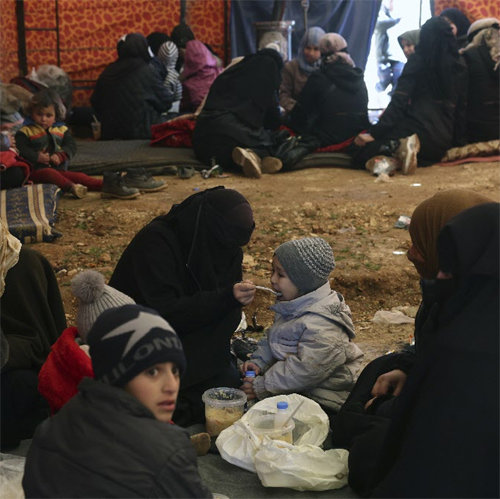13 years of civil war, 4 million people in Turkey
300 corpses returned to their hometown in two days
Aid cut off due to sanctions, “crisis within crisis”
Syria bombs earthquake-stricken rebels
“Anyone who did not die in the civil war in Syria died in an earthquake in Türkiye.”
Syria, which has suffered from a civil war that has continued since 2011 and violence by the Sunni terrorist group Islamic State (IS), is in greater pain due to the strong earthquake. On the 8th, the New York Times (NYT) and CNN of the United States reported that Syrian refugees who crossed to Turkey to escape the civil war returned to their hometowns with cold corpses from the earthquake. It means that the suffering does not end even in life or death.
According to the United Nations, 13 million Syrians, more than half of the total population (21 million), have fled their homes after the civil war broke out. Of these, about a third, or 4 million, came to neighboring Turkey. In the midst of this, more than 3,000 people died in Syria alone as of the 9th due to the strong earthquake that broke out in northern Syria and Turkey on the 6th. It is difficult to compile accurate statistics due to the civil war, so the actual death toll is likely to be much higher.
 Syrian refugees sheltering from the cold in tents On the 8th, in Idlib, northern Syria, close to the southern border of Turkiye, victims of the devastating earthquake shelter from the cold in tents set up by relief organizations on the dirt floor. A woman is feeding her child relief food. Idlib = AP Newsis
Syrian refugees sheltering from the cold in tents On the 8th, in Idlib, northern Syria, close to the southern border of Turkiye, victims of the devastating earthquake shelter from the cold in tents set up by relief organizations on the dirt floor. A woman is feeding her child relief food. Idlib = AP NewsisAccording to CNN, on the 7th and 8th, more than 300 bodies passed through the border control post ‘Bab al-Hawa’ adjacent to Turkiye. Some of the corpses that could not be placed in body bags were wrapped in blue tarpaulins or blankets. For three days, up to the 8th after the earthquake, no aid items were sent to this control center, and only body bags passed through.
Ahmad Al-Yousuf (37), who said he had come to retrieve the body of Yara, a 13-year-old niece of her cousin, told the NYT on the 8th that “Yara’s parents and siblings are still in the rubble of a collapsed building.” She also said that she was in the position of living in a tent, but she took care of the apprenticeship. She also stated that she would continue to come here until Yara’s body was retrieved by her family.
The area around the control center was full of people trying to identify the body. One man hesitated, saying, “I can’t” when another man said, “Check the body of my sister.” He said that he was afraid that the faces of the dead would be remembered forever. Eventually, another man was identified instead.
Endemic internal conflicts in Syria, a multi-ethnic, multi-religious, multi-sectarian state, have also increased the suffering of the people. President Bashar al-Assad, who came to power in 2000, is an Alawite sect. After he came to power, his brutal suppression of his opponents accumulated disaffection from the Sunni majority, and civil war broke out.
While the Assad regime even used chemical weapons against rebels, some Sunni extremists joined IS. The Kurds, an ethnic minority, also advocated secession. Sunnis, Kurds and ISIS are on the ‘anti-Assad’ front. However, Sunnis and Kurds were also in a state of division, keeping their distance from IS.
The interests of major powers are also complex. The West, including the United States, supported the rebels for the reason of ‘defeat IS – anti-Assad’. Russia is a supporter of the Assad regime. IS has disappeared with the support of the West, but the difference between the positions of the remaining forces is sharp. Elmostafa Ben Ramlih, the United Nations humanitarian coordinator in Syria, diagnosed Syria with a “crisis within a crisis” by saying, “There are many ghost towns whose infrastructure has been paralyzed by civil war.”
According to the British Daily Mail, the Assad regime also bombed rebel-held northern Marea on the 6th when the earthquake occurred. Alicia Kerns, a member of the British House of Commons, criticized, “While Marea was fighting the earthquake damage, the ‘opportunist’ President Assad attacked relentlessly and mercilessly.” The United States and the European Union have consistently sanctioned the Assad regime. As it became difficult to bring in relief goods due to sanctions, the Assad regime requested help from the EU on the 8th, and the EU also agreed to help. On the 9th, UN structures arrived in Syria for the first time since the earthquake.
Source: Donga
Mark Jones is a world traveler and journalist for News Rebeat. With a curious mind and a love of adventure, Mark brings a unique perspective to the latest global events and provides in-depth and thought-provoking coverage of the world at large.